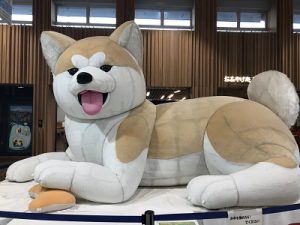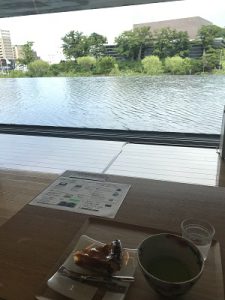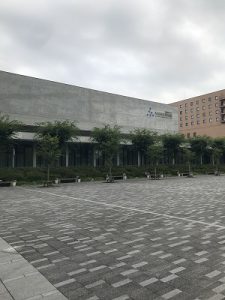秋田県立美術館(愛知県名古屋市千種区姫池通 骨董買取致します 古美術風光舎)
2022.08.17
皆さま、こんにちは。スタッフNでございます。
ニュースで暑すぎて向日葵がかれてしまったそうです。
夏の代表なのに枯れてしまうなんて悲しすぎます。
甲子園の高校球児も心配ですし、早くちょうどいい夏の気温になってほしいものです。
さて先日、秋田県立美術館に行って参りました。

この時期の秋田県は愛知県と違ってからっとしており、とても過ごしやすかったです。
秋田県立美術館と言えば、世界的な画家藤田嗣治が、昭和12年当時の秋田を描いた大壁画「秋田の行事」が有名でございます。
カンバス貼りの油彩の大きさは約3700号という驚きの大きさでございます。
フランスから帰国後の個展で知りあい、藤田の支援者となった秋田の富豪の平野政吉は、秋田を題材にして巨大壁画を注文します。
藤田が映画の監督・撮影のため秋田を訪れたさい、「世界一の絵を」と頼み、制作の依頼をしたそうです。
秋田県立美術館は、幅20m余にも及ぶ「秋田の行事」をはじめとする公益財団法人平野政吉美術財団の所蔵する作品の展示をメインとしながら、秋田市の中心市街地にある千秋公園を望む地といった特徴を活かし、「ここにしかない魅力のある美術館」をコンセプトに設計されました。
また、旧県立美術館の持つ最大の特徴であり県民の皆様の心に溶け込んでいる三角形屋根に呼応するように、三角形をモチーフとしたデザインになっています。
設計者は、独学で建築を学び、プリツカー賞、文化勲章など数多くの賞を受賞し、国内はもとより海外からも高い評価を得ている安藤忠雄でございます。
壁の支えや柱のない螺旋階段、水庭越しに千秋公園の美しい風景を存分に楽しむことが出来る解放感あるラウンジ空間、そして美術館と街とをつなぐ大きな三角形吹抜けのエントランスホールなど新しい県立美術館にはたくさんの見どころがありました。
特に、大きなガラス窓から映画のスクリーンを見ているかのようなミュージアムラウンジは、ずっとここにいたいと思えるほど素敵な場所でございました。
ソファーに座ってくつろぐことができます。コーヒーやケーキなどをご注文いただけます。
近所にあったらNは毎日通っていることでしょう。
優雅にアップルパイをいただきました。

動画をTikTokとInstagramにあげましたので、ご興味あれば是非ご覧くださいませ。
美術館に入ってすぐに目に飛び込んでくる螺旋階段は、壁からの支えや柱がありません。
若い子が階段の真ん中でポーズをとっておりまして、どうやらインスタ映えスポットになっているようです。
Nも頑張ってみましたが、これが限界でした。

秋田市の商人町で米穀商を営み、県内有数の資産家でもあった平野家の三代目です。
東京都牛込区(現在の新宿区)で、後に陸軍軍医総監となる藤田嗣章の次男として生まれました。
ではでは

Hello everyone. I am Staff N.
It seems that the sunflowers have been burned in the news because it was too hot.
It’s too sad that it withers even though it’s a representative of summer.
I’m also worried about high school baseball players at Koshien, and I hope that the summer temperature will be just right as soon as possible.
Well, the other day, I went to the Akita Prefectural Museum of Art.
Unlike Aichi Prefecture, Akita Prefecture during this period is dry and very comfortable.
Speaking of the Akita Prefectural Museum of Art, the world-famous painter Tsuguharu Fujita is famous for the large mural “Akita’s Events” depicting Akita at the time of 1937.
The size of the oil painting on canvas is about 3700, which is a surprising size.
Masakichi Hirano, a wealthy man from Akita who met Fujita at a solo exhibition after returning from France and became a supporter of Fujita, ordered a large mural with Akita as the theme.
It is said that when Fujita visited Akita to direct and shoot a movie, he asked for “the best picture in the world” and asked him to produce it.
The Akita Prefectural Museum of Art is located in the center of Akita City, overlooking Senshu Park, and mainly exhibits works from the collection of the Masakichi Hirano Art Foundation, including the 20-meter-wide “Events of Akita”. Taking advantage of these characteristics, it was designed with the concept of “an attractive museum that can only be found here.”
In addition, the design is based on a triangular motif, in line with the triangular roof, which is the greatest feature of the Former Prefectural Museum of Art and which has melted into the hearts of the citizens of the prefecture.
The designer is Tadao Ando, a self-taught architect who has received numerous awards, including the Pritzker Prize and the Order of Culture, and has received high acclaim both domestically and internationally.
A new prefectural art museum with a spiral staircase without wall supports or pillars, a spacious lounge space where you can fully enjoy the beautiful scenery of Senshu Park over the water garden, and a large triangular atrium entrance hall that connects the art museum and the city. had many attractions.
In particular, the museum lounge, which looks like you’re watching a movie screen through the large glass windows, is such a wonderful place that you’ll want to stay here forever.
You can sit on the sofa and relax. You can order coffee, cake, etc.
If I lived nearby, I would go to N every day.
I had a nice apple pie.
I posted the video on TikTok and Instagram, so please take a look if you are interested.
The spiral staircase that catches your eye as soon as you enter the museum has no support from the walls or pillars.
A young girl is posing in the middle of the stairs, and it seems to be an Instagrammable spot.
I tried my best with N, but it was the limit.
Here, I tried to find out about Hirano Masakichi.
1895 (Meiji 28) to 1989 (Heisei 1)
He is the third generation of the Hirano family, who ran a rice merchant in Akita City’s merchant town and was one of the most wealthy people in the prefecture.
From his youth, he became interested in ukiyo-e, antiques, and paintings from the Edo period, and devoted his life to collecting works of art.
Hirano first saw the works of Tsuguharu Foujita in 1929 (Showa 4) at a solo exhibition when Foujita temporarily returned to Japan.
Later, in 1934, Hirano and Fujita met at the Nika Exhibition in Tokyo.
In 1936, following the sudden death of Fujita’s wife, Madeleine, Hirano envisioned the construction of a museum in memory of her.
He purchased many of Fujita’s large-scale works and proceeded with Fujita’s mural paintings.
However, construction of the museum was canceled during the war.
About 30 years later, in 1967, Hirano founded the Masakichi Hirano Museum of Art to display the works of art he had collected over the years, hoping to “enrich young people.”
In May of the same year, the Akita Prefectural Museum of Art, which exhibits the Masakichi Hirano collection, opened and continues to this day.
Fujita’s works, which are the core of the Masakichi Hirano collection, are widely known as a group of works that provide an overview of Fujita’s painting career in the 1930s.
Actually, an acquaintance of N in Akita is an acquaintance of Masakichi Hirano, and I was surprised to learn recently that he had visited his house.
As I’m sure you all know, I would like to touch on Tsuguharu Fujita.
1886 (Meiji 19) to 1968 (Showa 43)
He was born in Ushigome Ward (currently Shinjuku Ward), Tokyo, as the second son of Tsuguaki Fujita, who later became Surgeon General of the Army.
After graduating from the Department of Western Painting at the Tokyo School of Fine Arts, he went to France in 1913 (Taisho 2).
In Paris, he established his style of painting with nudes drawn with smooth outlines on a smooth milky-white background, and was highly acclaimed.
In 1931, he left Paris and visited Central and South America.
From around this time, his style of painting became predominantly rich in color. In 1933, he returned to Japan. He became a member of Nika and produced murals in Tokyo, Osaka and Kyoto.
Together with Masakichi Hirano, a wealthy man from Akita City, he conceived the construction of an art museum.
In 1937 (Showa 12), he completed the mural “Events in Akita”.
During the war he produced war paintings.
In 1949, after Japan’s defeat in the war, he left Japan and went to the United States.
He returned to Paris the following year.
He obtained French citizenship, after which he was baptized Catholic.
He designed the Chapel of Reims and also created the frescoes inside.
He died in Zurich in 1968.
There is also “FOUJITA”, which depicts the life of Tsuguharu Fujita, which was made into a movie starring actor Joe Odagiri.
Tsuguharu Fujita is famous for his love of cats, and the Akita Prefectural Museum of Art also has paintings featuring cats, such as “Sleeping Woman”.
What is Akita Prefecture? There are many people who say they have never been there, but why not go to a little-known museum at this time of year?
If you are lucky, you can enjoy it as a charter.
In front of the Prefectural Museum of Art, there is also an Akita dog station where you can interact with Akita dogs.
When N went, I was on vacation so I couldn’t meet him, but I was able to meet him at Senshu Park.
The quiet, dignified and cute Akita dog was wonderful.
A large Akita dog stuffed toy appears everywhere in airports, train stations, etc., so I think it’s a must for dog lovers.
At Kobijutsu Fukousha, we also purchase paintings by Tsuguharu Fujita and others.
See you soon



*********************
夏の帰省などで、ご実家の整理やお片付けなどをされている方のご相談などが多くございます。お暑い日が続きますのでくれぐれもご無理のないように、なさってくださいませ。風光舎では、古美術品や骨董品の他にも絵画や宝石、趣味のお品など様々なジャンルのものを買受しております。
お片付けをされていて、こういうものでもいいのかしらと迷われているものでも、どうぞお気軽にご相談下さいませ。
また風光舎は、出張買取も強化しております。ご近所はもちろん、愛知県内、岐阜県、三重県その他の県へも出張いたします。
まずは、お電話お待ちしております。
愛知県名古屋市千種区・骨董 買取
『古美術 風光舎 名古屋店』
TEL052(734)8444
10:00-17:00 OPEN

